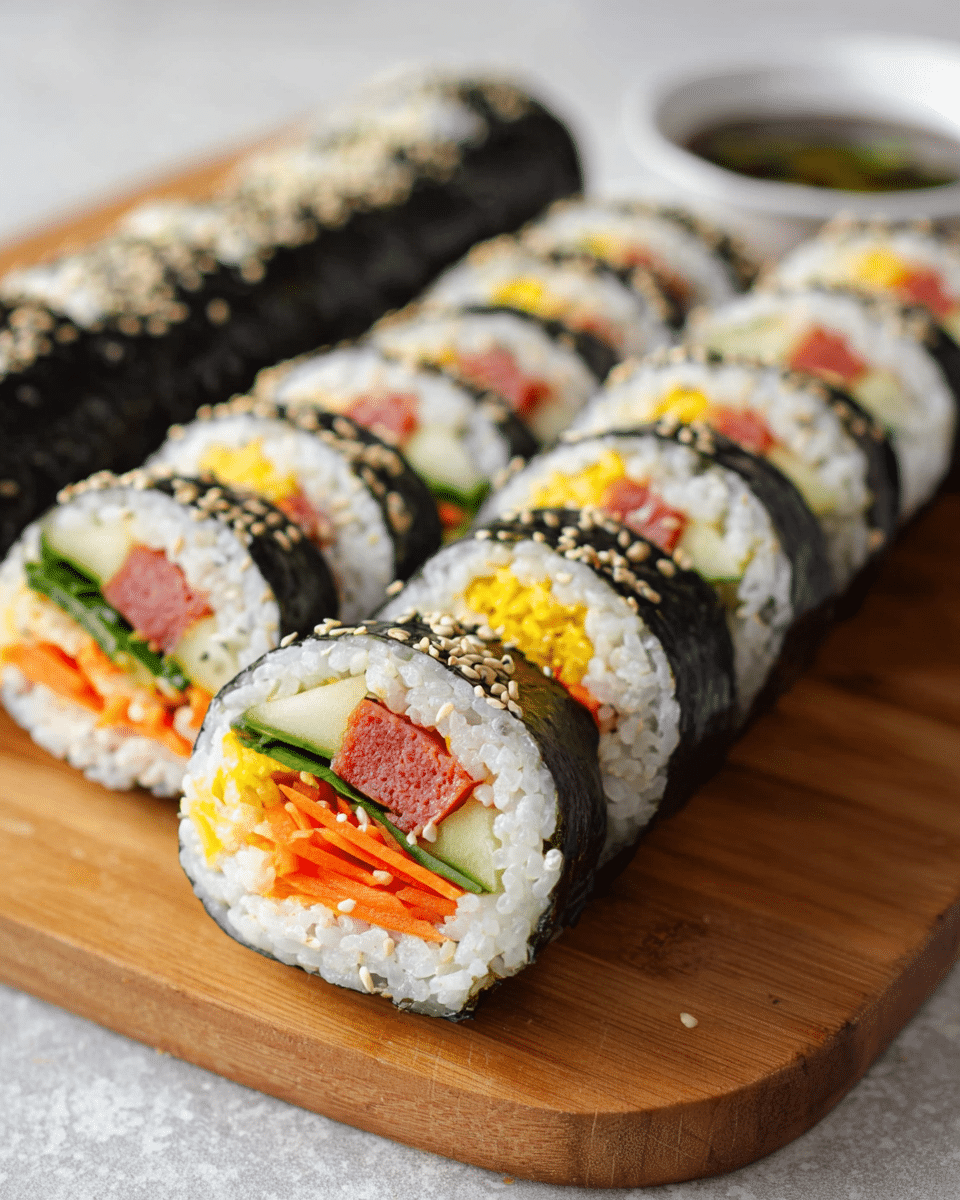Spam Kimbap is a delightful Korean dish that combines crispy Spam with fresh vegetables and a hint of soy sauce, all wrapped in flavorful nori and sticky rice. The result is a perfect balance of textures—crispy, crunchy, and tender—offering a satisfying bite with every piece.
This dish is not only delicious but also quick and easy to make. It’s a great option for meal prep, a snack, or even a fun lunch idea for the whole family. Plus, it’s fully customizable with your favorite fillings, so you can adjust it to your taste. Whether you enjoy it with pickled radish or a spicy kick, Spam Kimbap is sure to satisfy your cravings.
Full recipe:
Ingredients:
-
2 cups cooked sushi rice
-
1 can of Spam, sliced into thin strips
-
5-6 sheets of nori (seaweed)
-
1/4 cup pickled radish, sliced into thin strips
-
1/4 cup cucumber, julienned
-
1/4 cup carrot, julienned
-
1 tablespoon sesame oil
-
1 teaspoon soy sauce
-
1 teaspoon sesame seeds
-
Salt and pepper to taste
Directions:
-
Cook the sushi rice according to package instructions, then let it cool slightly.
-
Heat sesame oil in a pan over medium heat. Add the Spam slices and sauté for 3-4 minutes until they are crispy and golden.
-
Lay a sheet of nori on a bamboo sushi mat. Spread a thin layer of rice over the nori, leaving a small margin at the top.
-
Layer the sautéed Spam, pickled radish, cucumber, and carrot over the rice.
-
Drizzle a little soy sauce over the filling and sprinkle with sesame seeds.
-
Carefully roll up the kimbap, pressing gently as you go to ensure it sticks.
-
Slice into 1-inch pieces and serve with a side of pickled radish or kimchi.
Prep Time: 15 minutes | Cooking Time: 10 minutes | Total Time: 25 minutes Kcal: 300 kcal | Servings: 2 servings
The Origins of Kimbap
Kimbap, often called the Korean version of sushi, has its roots in Korea, where it has been a popular dish for centuries. The word “Kimbap” translates to “seaweed rice” in Korean, with “Kim” meaning seaweed and “Bap” meaning rice. This dish was historically a simple, practical food that could be easily packed for lunch or picnics, making it a great meal for those on the go.
Though Kimbap is similar to Japanese sushi rolls, it differs in several key ways. While sushi typically uses raw fish, Kimbap is made with cooked ingredients such as beef, egg, vegetables, or in the case of Spam Kimbap, the iconic canned Spam. The ingredients are rolled tightly in nori and served cold, which makes Kimbap both easy to prepare and convenient for lunchboxes or casual gatherings.
Spam Kimbap: A Fusion of Cultures
Spam Kimbap is a fusion dish that has gained popularity not just in Korea but globally. Spam, a canned meat product made primarily from pork, was introduced to Korea during the Korean War in the 1950s. Due to its long shelf life and affordability, it became a common food item, especially in times of scarcity. Over the years, Koreans have embraced Spam as a key ingredient in various dishes, one of the most popular being Spam Kimbap.
Spam Kimbap is made by filling nori rolls with cooked rice, sautéed Spam, and other fresh ingredients like pickled radish, cucumber, and carrots. This version of Kimbap provides a savory and satisfying twist on the traditional roll, incorporating the rich, salty flavor of Spam with crunchy vegetables and sticky rice. It’s a perfect balance of flavors and textures, with the salty Spam complementing the freshness of the vegetables and the umami of the rice.
Why Spam Kimbap is So Popular
Spam Kimbap has become a beloved dish for a variety of reasons. Firstly, it’s incredibly convenient. The preparation is straightforward, and it doesn’t require any special ingredients or elaborate techniques, making it ideal for a quick meal or snack. The dish is also versatile, with endless possibilities for customization. Whether you prefer more vegetables, extra Spam, or even a drizzle of spicy sauce, Spam Kimbap can be adapted to suit your personal taste.
Moreover, Spam Kimbap is a comforting food for many. It brings back memories of family gatherings, picnics, or simple meals shared with friends. The addition of Spam gives the dish a nostalgic, hearty flavor, making it a favorite among many.
Health Benefits of Spam Kimbap
While Spam Kimbap is not necessarily the healthiest option on the menu, it does offer a variety of nutrients. The dish contains a balance of carbohydrates, protein, and fats, making it an energy-boosting meal. The rice provides a good source of carbs, while the Spam adds protein and fat. Vegetables like cucumber, carrots, and pickled radish provide essential vitamins and fiber.
However, Spam does have a high sodium content, which means it should be enjoyed in moderation. If you’re concerned about the salt content, you can opt for low-sodium Spam or use less Spam in your Kimbap to reduce the overall salt intake. Additionally, you can add more vegetables to increase the fiber content and balance the dish out.
In terms of dietary preferences, Spam Kimbap can easily be customized to meet vegetarian or vegan needs by replacing the Spam with other plant-based proteins like tofu or tempeh. You can also add additional veggies like spinach or bell peppers for more variety.
Serving Suggestions for Spam Kimbap
Spam Kimbap is incredibly versatile when it comes to serving options. It can be enjoyed on its own as a quick snack or paired with side dishes for a more complete meal. Here are some ideas for serving Spam Kimbap:
-
With Kimchi: Kimchi, a spicy fermented cabbage dish, is a classic Korean side dish that pairs wonderfully with Spam Kimbap. The tangy, spicy flavor of kimchi complements the savory Spam and adds an extra layer of flavor to the meal.
-
As Part of a Bento Box: Spam Kimbap makes a great addition to a bento box, along with other traditional Korean side dishes like japchae (stir-fried noodles), steamed vegetables, and pickled radishes.
-
With Soup: Spam Kimbap is often served with a bowl of hot soup, such as a simple miso soup or a Korean vegetable soup like miyeok-guk (seaweed soup). The soup adds warmth and balances out the flavors of the Kimbap.
-
As a Party Snack: Spam Kimbap can also be served at parties or gatherings. Its bite-sized nature makes it easy to pick up and enjoy without the need for utensils. You can make a variety of Kimbap rolls with different fillings to cater to different tastes.
Variations of Spam Kimbap
While the basic version of Spam Kimbap features Spam, rice, and vegetables, there are many ways to get creative with the fillings. Here are a few popular variations:
-
Spam and Egg Kimbap: A scrambled egg is added to the roll, giving it an extra richness and creaminess. The egg can be cooked into a thin omelet and placed alongside the Spam for added texture.
-
Vegetarian Spam Kimbap: For those who want a meatless version, the Spam can be substituted with other ingredients like tofu or tempeh, providing the same savory and protein-rich filling.
-
Spicy Spam Kimbap: For a kick of spice, add some gochujang (Korean chili paste) to the Spam or drizzle it over the finished rolls. This adds heat and enhances the overall flavor profile of the dish.
-
Tuna Kimbap: Another variation is to swap Spam for canned tuna. This version is lighter and often flavored with a bit of mayonnaise, making it creamy and delicious.
Conclusion
Spam Kimbap is a delightful fusion of flavors and textures that has become a beloved dish in Korean cuisine. With its origins rooted in practicality and convenience, it has evolved into a go-to comfort food for many. Whether you’re enjoying it as a snack, a lunch, or a party appetizer, Spam Kimbap is sure to please with its savory taste and satisfying bite. While it’s not the healthiest dish out there, it provides a well-balanced combination of protein, carbs, and vegetables. It’s a dish that you can easily customize to your preferences, making it both versatile and fun to prepare.
So, next time you’re craving something flavorful, simple, and satisfying, give Spam Kimbap a try. You’ll be enjoying a taste of Korean comfort food that has captured the hearts of many worldwide.






